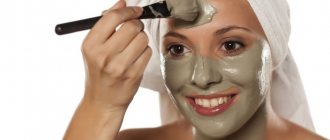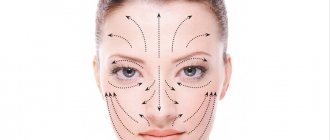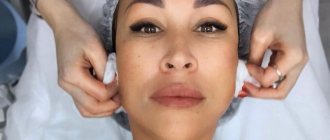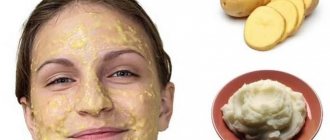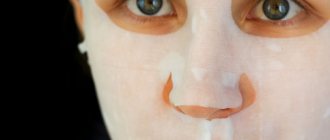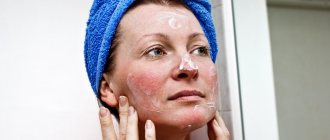Modern cosmetics are very diverse in composition, and it so happens that a new mask suddenly produces an unpleasant result - a red face after a mask, skin irritation, an allergy to clay. What to do in this case and what could be the reason? Despite the fact that the result is the same: after application the face turns red, it can be caused by various reasons.
What you will learn:
- Causes of facial redness after a mask Allergy to clay
- Features of the mask
- Skin irritation
- Poorly cleansed skin or dirty hands
- What to do to avoid redness
Clay, due to its healing properties[1], has been widely used in skin care for a long time.
As studies show[2], the use of certain types of clay helps eliminate excess sebum, cleanse and refresh the skin, and also promotes the healing of pimples[3]. However, there are still several myths surrounding clay masks. We'll look at three of the most common mistakes and give tips on how to get the most out of your mask.
Redness after clay
Various clay masks are popular among women because they:
- Very affordable.
- Suitable for regular use.
- Promotes deep cleansing of the skin.
- Effectively relieve rashes.
- Eliminate inflammation.
- Helps cope with oily epidermis.
- They can whiten the skin, eliminate facial wrinkles, tone, moisturize and nourish.
Clay is considered a fairly hypoallergenic substance. Therefore, the risk of allergic reactions after its use is very small. However, after a clay mask, the face often turns red - locally or completely. Most often, this effect is explained by a temporary reaction of the epidermis of a non-allergic nature. During deep cleansing and warming up, redness is completely normal. Usually it goes away quite quickly.
But the possibility of allergies should not be ruled out. If the reddened skin itches and itches, and, even more so, if a rash appears on it, perhaps we are talking about individual intolerance.
Mistake 1: Choosing a mask without taking into account your skin type
Clay is the basic term for different types of mineral compounds, and each type of clay has different properties. This means that there is a specific type of clay for a specific skin type and specific needs. White clay is a gentle micro-granular cleanser that removes excess sebum without drying out the skin (so great for sensitive and dry skin). Green clay has more powerful adsorption and absorption properties, making it more suitable for oily skin. Charcoal—actually pure carbon rather than clay—is known for its ability to cleanse the skin of impurities and toxins.[4]
Causes of facial redness after a mask
Allergy to clay
This option is especially likely when the mask is new and has not been tried before. If your face is red and itchy, it may be an allergy to one of the components of the mask.
You should not immediately dismiss this option, even if the mask was recommended by a friend whose cosmetics did not cause any consequences. It is important to remember that all people have different skin and body characteristics, so it is quite possible that the mask will suit someone without problems, but will cause an allergic reaction in others.
The product has already been used before and did not cause any complaints, but suddenly your face turns red after the mask? It could still be the same allergy. It happens that during chemical processes in the body, some component may begin to cause allergies, although there were no such reactions before.
Features of the mask
Some products have a certain effect , after which it looks red for some time.
But this is an absolutely normal effect, and soon the redness will disappear on its own, so there is no need to panic or get upset, you just have to wait. In addition, the mask can cause a rush of blood to the skin due to its warming effect - hence the redness, which, in this case, is also completely normal.
Skin irritation
For various reasons, irritation may occur , causing redness. Some components of natural masks can slightly scratch the skin, hence the appearance of irritation. In addition, if the mask is not suitable for your skin type and, for example, dries it out, this can also cause a similar effect.
Poorly cleansed skin or dirty hands
Redness and irritation can be caused by simple lack of hygiene. If you do not cleanse your face before applying a mask or carry out the procedure with dirty hands, this can cause tiny particles of dirt to get into the enlarged pores of the face and, as a result, redness and inflammation on the skin.
Mistake 2: Keeping the clay mask on for more than 10 minutes
Clay face masks penetrate the skin, absorbing excess sebum (absorption) and drawing out and binding impurities (adsorption). This means that if you leave the mask on for too long, the clay can dry out your skin. Instead of waiting for the mask to dry completely on your face, leave it on for no more than 10 minutes, as recommended for use with the Pureté Thermale Pore Purifying Clay Mask. If your skin feels dry or tight after removing the mask, use Mineral 89 soothing mineralized water to instantly restore moisture balance.
Masks for chemical and mechanical peeling
Mechanical peel masks contain particles that can scratch the skin. This could be, for example, parts of an apricot kernel, pumice stone or grains of salt. Therefore, if your face turns red after a mask, most likely your delicate skin reacted with irritation to such exposure.
Chemical masks differ in the content of acids, which, although small, can still cause a chemical burn. In this case, the redness resembles sunburn.
What to do to avoid redness
To avoid unpleasant redness on the skin caused by the use of masks, you need to follow some recommendations.
- In case of allergies, you should consult a dermatologist - the doctor will tell you what could be the cause, and also prescribe medications to relieve symptoms. Of course, you need to avoid masks with the component that causes allergies and carefully study the composition.
- Select masks that suit your skin type.
- Before using the mask, you need to apply a little to a small area of skin on your arm and wait. If everything is in order, you can safely use the mask, but reddened skin or itching will warn you that it is better not to use the mask.
- Follow simple hygiene rules, clean your face before applying the mask and wash your hands.
- For delicate skin, it is better to choose masks that do not have too strong an effect.
- Follow the mask instructions if provided. Redness may appear because the mask has simply been left on the face for too long.
- Take care of your skin in a timely manner, using emollient creams and lotions appropriate to your skin type.
Following these simple tips will help you avoid redness on the skin associated with the use of masks, keep your skin healthy, and if trouble does occur, quickly deal with the consequences.
Why do you need cream after a clay mask?
When applying cream after a clay mask, do not forget about additional care. Clay eliminates the main problem, and the secondary problem is solved by face cream.
That is, clay can cleanse the skin, and the cream will moisturize it, the clay will rejuvenate the skin, and the cream will contribute to this. Some types of clay are “double-sided”: they care for the skin, nourish and moisturize, but with frequent use they lead to dehydration. And overuse of clay masks leads to skin losing elasticity and aging quickly.
White clay has an aggressive effect on the skin of the face if used in its pure form, diluted only with water. Additional ingredients are required. White clay for skin can be used once a week , otherwise the process of destroying the acid-base balance will begin.
More mature skin requires additional care. If you have a normal skin type, then you can use regular baby cream as a moisturizer, but in other cases you need to take care of what to apply to the skin after the mask, since skin that requires care needs additional hydration.
Skin types and face cream
Before choosing clay for a mask, you need to familiarize yourself with the structure of the skin and decide whether cream is needed after the face mask. There are 4 skin types: dry, normal, oily and combination.
To determine your type, remove all makeup from your face using a special product and wash thoroughly so that no traces of foundation or powder remain. Wait 2-3 hours and assess the condition of the skin in daylight. And only after that proceed to cosmetic procedures.
As you use the mask, you need to monitor the condition of your skin. Depending on which mask you use, your skin type may change, at least temporarily. Do you need cream after the mask? Yes, it is necessary, regardless of skin type.
Skin type 1 – Dry
What does the skin look like?
If you think about it, dry skin looks great, there are no pores or blackheads, and there is no oily shine at all. But when there is frost or cold, the skin begins to peel off, which is not the best sight. In addition, dry skin types are more susceptible to stress, as a result of which they age quickly.
What you need after a clay mask.
As a mask, you can use gray clay, which helps moisturize and gently cleanse the skin of the face. And now what you need after the gray clay mask:
- A moisturizer that should be completely free of alcohol-containing components to avoid overdrying.
- Intensely moisturizing creams can be used only once a week, even if the skin is very dry. Preferably after the mask.
- And for daily use, a cream with natural oils and vitamin C is suitable.
Skin type 2 – Normal
What does the skin look like?
In appearance, normal skin type looks ideal - it is elastic, with a natural shine, firm and looks fresh. There are no pores or wrinkles and caring for it requires minimal time and effort. When making face masks, blue clay is often used, which helps increase elasticity and firmness.
What to apply after the mask to the skin.
Normal facial skin also requires care. Basically, it consists of moisturizing and maintaining tone, for which green clay is also suitable, which also allows you to increase elasticity. When choosing a cream after a mask, you need to consider the following:
- Intensely moisturizing creams cannot be used; regular cream is sufficient.
- Collagen cream is suitable for regular care.
- You can use face creams with essential oils.
Skin type 3 – Oily
What does the skin look like?
This type of skin is easy to determine - it looks unkempt and has enlarged pores, there are constant companions - acne, and there is also an unpleasant oily sheen. Inflammations often appear in the form of purulent pimples, which indicates a violation of the metabolic process in the body. White clay is used precisely to improve the appearance. It is able to absorb oily shine, eliminate pores, clear blackheads and even out the complexion.
Do I need cream after the mask?
Usually women prefer to leave everything as it is: they use clay, they like the effect and they don’t even remember about the cream. Why, everything is fine anyway. But after a while everything returns to its place - the skin becomes oily again. And all because no moisturizing cream is used. But in vain.
- Moisturizing cream is a must. As mentioned above, white clay dries out the skin.
- Moisturizer should be chosen with a gel base, so it absorbs more easily, without remaining on the surface and without forming a greasy layer.
- When choosing a cream, you can choose ones that are based on brewer's yeast.
Skin type 4 – Combination
What does the skin look like?
Well, what can we say - the skin looks terrible and this is the most difficult skin type that requires A LOT of care. The area of the forehead, chin and nose is often oily, with enlarged pores and blackheads. The skin of the cheeks is dry and in cold weather requires constant hydration.
What to do?
Let's try to figure out what to do if your face turns red after the mask:
- Try lubricating your skin with Panthenol or Bepanten. This is a safe pharmaceutical cream that contains dexpanthenol, a derivative of one of the B vitamins. This substance effectively accelerates skin restoration, helps increase the density of collagen fibers, and also optimizes metabolism in cells. Creams with dexpanthenol are often used in the treatment of skin diseases and burns.
- You can also apply a regular moisturizer or nourishing cream to the skin.
- If there is severe itching and other symptoms of an allergic reaction, take any antihistamine, for example, Loratadine, Cetrin or Zyrtec in the amount of one tablet. Such drugs effectively eliminate the symptoms of individual intolerance in literally half an hour to an hour.
- If you suspect an allergy, do not use clay masks anymore.
- If there are no allergic manifestations, check how suitable the chosen product is for you. In particular, owners of combination skin should use some drying and deep cleansing compositions only on the T-zone, and on the cheeks such masks will naturally cause irritation.
If redness of the epidermis is a natural non-allergic reaction of the skin to clay, try to make the mask in the evening. Then the skin will have every opportunity to recover before morning.
What to choose
Is it necessary to apply cream after the mask? Necessarily! But which one? This is where it is difficult to make a choice.
Before buying a suitable product, we recommend comparing them by composition online on a special website.
Even based on these tips, some cream may absolutely not suit one woman, while another may find it ideal. You shouldn’t base your decision on your friend’s advice; you are two different people with different skin textures. Study the compositions, experiment and only after that you will find exactly your face cream.
Choosing clay for different skin types
- White clay or kaolin is a “soft option” that is most often used in Korean masks for problematic and oily skin.
 The benefits of a white clay mask cannot be overestimated. This component carefully cleanses and absorbs sebum and softens even the most sensitive skin. Oily skin will also like kaolin due to its anti-inflammatory and healing effect.
The benefits of a white clay mask cannot be overestimated. This component carefully cleanses and absorbs sebum and softens even the most sensitive skin. Oily skin will also like kaolin due to its anti-inflammatory and healing effect.
- The famous ghassoul clay , which is obtained in Morocco, nourishes, saturates with valuable minerals and trace elements, reduces inflammation and heals the skin. It is a mask with Moroccan volcanic clay for the face that best moisturizes the skin, because gassoul can retain a large amount of moisture. Clay softens even very dry, tired skin.
- Pink clay will soothe your dry and sensitive skin, relieve irritation and flaking. And for aging skin it will prevent the appearance of wrinkles.
- Blue clay is great for normal to combination skin. Blue clay face masks help get rid of acne and cleanse, as well as nourish and tone the epidermis.
- Green clay also takes care of skin susceptible to age-related changes, restoring its softness and elasticity. It also maintains an optimal level of moisture and, thanks to its powerful antibacterial properties, cleanses pores, treats acne and relieves redness.
Soothing clay mask with green tea. 75 ml, RUB 2,150
